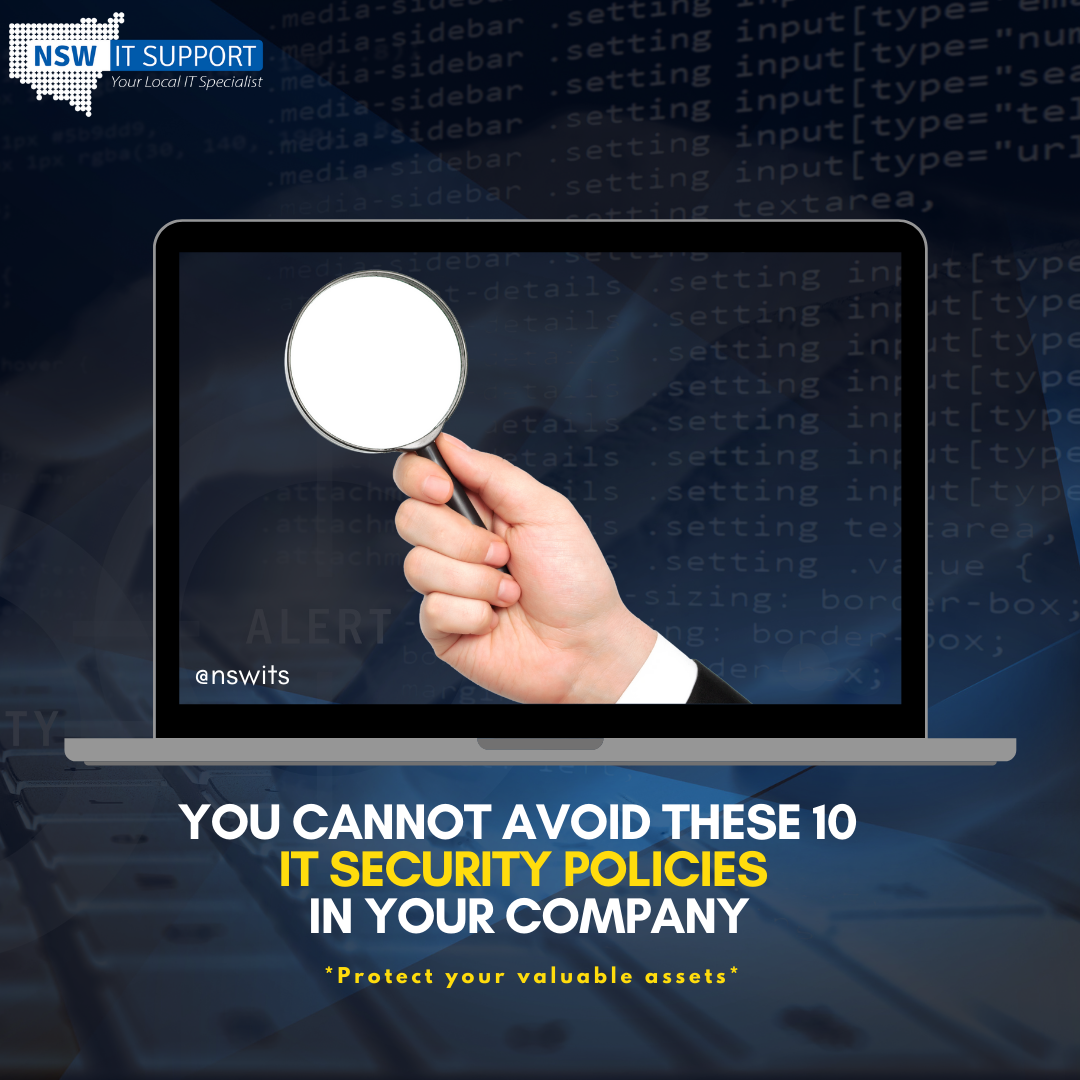Without an IT security policy, it is somehow impossible to coordinate and enforce the security program, especially on the ongoing norm of work from home. IT security policies are a pivotal success of any company before or after the pandemic. These have become a sound support system for cybersecurity, internal procedures aligning to its mission, and commitment to safety.
IT security policy defines the individual responsibilities within the company. IT security policies shape the company’s preparedness, response, mission, and achievement to security incidents. A well-documented approach is acknowledged and followed by all other employees of the organisation.
Having comprehensive security policies supplies countless benefits for a company. The procedure can improve the overall security shape of that organisation. In addition to setting up IT security policies, audit preparation also ensures proper compliance with regulations, including accountability for both the user and the partner within the company that could be beneficial for both the company from a business perspective and legal perspective.
Defining cybersecurity policies for the business leaf
Cybersecurity policies define how employees, partner, consultants, board members access the company applications, IT devices, and reasonable security practice. Typically, the first segment of cybersecurity defines the basic requirements of anti-virus software and use of cloud applications, including the templates of remote work applications, wireless communication policy, password protection policy, digital signature policy and email policy.
The primary purpose of applying security policy within the company is to protect confidentiality, availability, and integrity of the system’s information and data that can customise the consequences and risk on the organisations’ valuable assets.
Organisations in the regulated industries can aid the IT consultants in NSW with the requirements, compliance checklists, and IT governance.
For a large organisation, the rules are drafted in dozens of pages. For small entity, the security policies are written on a few pages covering the basic security practices including,
- Rules for using email encryption.
- Steps for accessing the applications.
- Guidelines for safeguarding passwords.
- Rules on the use of IoT (Internet of Things), social media, confidential files & documents.
What are the IT security policies your company should have?
- Security Incident Response Policy:
Incidents will happen, and any company that wants to protect their data and information responsibly has a responsibility to protect it.
It is a primary policy needed to work together as the incident response strategy. The security incident response policy’s goal should evolve access policies and understand how the policy protects the business, employees, and clients.
- Change Management Policy:
Change management policy decides the formal process that changes an information system used for managing, approving, and tracking the IT software hazards, development, and security services/ operations.
The change management policy involves the planning, tactics, evaluations, reviewing, approval, communications, documentation, and post-change review.
The key feature that attracts everyone to implement the change management policy is that it increases the awareness and understanding of the proposed changes across the company and ensure that all changes are conducted as planned to minimise the unfavorable impact on the services and customers.
- Asset Management Policy:
Assets management policy is a crucial policy to understand your company’s technology print essential in setting up security controls.
It is the procedure of receiving, tagging, documenting, and eventually disposing of the equipment used to ensure that software licensing in full compliance minimises the risk and threats of legal and regulatory problems.
- Acceptable Use Policy (AUP):
Acceptable Use Policy (AUP) says the proper use of computer equipment, system network, and resources. It is the standard rewarding policy for all employees, contractors, and third parties that clearly understand its resources.
The AUP includes widespread use, proper behavior when using welfare or confidential information, and inappropriate use.
It is suggested that the company’s IT department, in consultation with the legal advisor and HR department, discuss the margin of AUP.
- Disaster Recovery Policy:
A disaster recovery policy (DRP) is a documented, organised perspective that defines how a company can quickly resume its work after uncertain/unplanned incidents. It is concerned with the aspects of a company that depends on any performing IT infrastructure.
Usually, the Disaster Recovery Policy is part of the business continuity plan (BCP). Your policy should explain the actions, tools, and procedures expected during an unpredicted workplace incident.
The goal of a Disaster recovery service is to help a company support and settle down the data loss and recover the system functions to perform in the effects of an incident, even if it runs at the minimum level.
- Account and Password Policy:
More than just setting or resetting the password lengths or pins, this policy defines the diverse types of accounts, their use, management, and added controls required as one-time passwords, multi-factor authorisation.
It guides on developing, implementing, and reviewing a documented process for appropriately creating, changing, and safeguarding solid and secure passwords used for verifying the account by finding the user identity and obtaining access to computer systems or information.
- Internet/Network Policy:
Internet access in the workplace needs to be restricted according to business needs only. It ties up the usage of personal space resources. Still, it also involves the risk and threats of spams, hacking, and virus, which can give easy access to the cybercriminals to get hold of your company’s confidential information.
The email should be conducted through business email servers and clients only unless your business is built around a structure that does not allow it. Developing agreements with employees and clients will minimise the risk and threats of sharing workplace information through social media platforms and unrecognised websites. This policy includes auditable actions for the caused situations.
- Regular Backup Policy:
You have heard many times about the daily backups. Malicious cybercriminals are eye-seeking your company’s confidential data and looking out for loops to get hold of the personal information (clients bank account information) to exploit your company information. Surprisingly, small businesses are at no spare.
The regular back up policy ensures and safeguard your information and data are protected at any costs through regular data backups to your cloud storage or using external devices that make your business secure.
- BYOD Policy:
BYOD (Bring Your Device) is a new norm and becoming popular in modern business. There are many pros of BYOD policy. It is cost-effective to lower hardware spend and increase employee productivity and work from any place.
However, if the BYOD is exclusively not checked, observed, or controlled, there is a risk of data loss and theft. The comprehensive policy will minimise individual security risks, employee confusion, interruption, and unnecessary costs.
- Device Management and Access Policy:
Proper methods to access entity device are set up to control access to information. The policy clearly defines the resource access, device usage and authorisation limitation.
As you design your device, consider employee well-being. The procedure for reporting data loss and business damage needs to be developed to address the issues to the concerned authority quickly.
Who should write your cybersecurity policies?
If not your trusted IT service provider, your IT department handles drafting your security policies. However, the stakeholders also make added contributions depending on the roles, ability, and responsibilities.
When inviting any person for participation in the policy development, consider the critical success of the policy.
Updating and auditing cybersecurity policies
Technology is leaping every year. Updating cybersecurity procedures every year or once a year is also necessary. Establish an annual review and update process involving the stakeholders.
When revising the policy, compare the guidelines with the actual policy practices. A policy audit directly pinpoints the rules that no longer address the current work process. It also identity is the better enforcement of the policy whenever needed.
NSW IT, an IT security consulting, suggests the following policy for audit goals.
- Comparing the actual and current policy
- Deciding the organisation’s internal threats and exposures.
- Evaluate external security threats and risks.
A defined cyber policy is an essential security resource for all the organisations. A careless approach can cost entity fines, legal fees, public trust loss, and brand degradation settlements. Creating and supporting policy prevents adverse outcomes.










